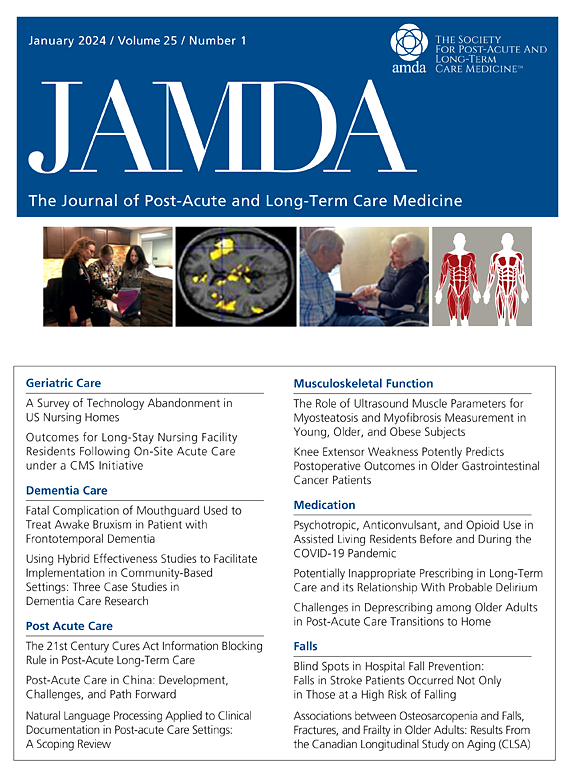Individuals with Cognitive Impairment Entering Long-Term Care: Characteristics and Cumulative Incidence of Dementia after Care Entry
IF 4.2
2区 医学
Q2 GERIATRICS & GERONTOLOGY
Journal of the American Medical Directors Association
Pub Date : 2025-04-10
DOI:10.1016/j.jamda.2025.105568
引用次数: 0
Abstract
Objectives
To characterize individuals entering long-term care facilities (LTCFs) with evidence of cognitive impairment and without a diagnosis of dementia, and to ascertain the cumulative incidence of dementia after care entry.
Design
Retrospective cohort study using the Registry of Senior Australians (ROSA) National Historical Cohort.
Setting and Participants
Individuals aged 65 to 105 years who entered LTCFs between 2009 and 2018, received a cognitive evaluation, and had no recorded dementia diagnosis at the time of care entry.
Methods
Cognitive function was determined via the Psychogeriatric Assessment Scales–Cognitive Impairment Scales (PAS-CIS) and defined as none or minimal (PAS-CIS score 0 to <4), mild (4 to <10), or moderate to severe (10 to 21). The cumulative incidence of dementia, determined by aged care assessments, hospitalization, medication, or cause of death, was ascertained for the total cohort and by cognitive impairment status at care entry.
Results
In total, 90,122 individuals [median age 85 years; interquartile range (IQR) 81–89; 64.6% female] were studied, of whom 76.6% (n = 69,075) had cognitive impairment, including 51.4% (n = 46,350) with mild and 25.2% (n = 22,725) with moderate to severe impairment. Over a median follow-up of 1.5 years (IQR 0.6–2.9), the cumulative incidence of dementia was 26.8% [95% confidence interval (CI), 26.5–27.1]. Stratification by cognitive impairment status showed the cumulative incidence of dementia was 17.4% (95% CI, 16.8–17.9) for none or minimal, 27.3% (95% CI, 26.9–27.8) for mild, and 35.3% (95% CI, 34.7–36.0) for moderate to severe.
Conclusions and Implications
The cohort of people entering LTCFs with cognitive impairment had a high incidence of dementia diagnosis within 1.5 years after entry. Routine cognitive impairment assessments can inform dementia screening strategies by identifying individuals at higher risk of dementia.
求助全文
约1分钟内获得全文
求助全文
来源期刊
CiteScore
11.10
自引率
6.60%
发文量
472
审稿时长
44 days
期刊介绍:
JAMDA, the official journal of AMDA - The Society for Post-Acute and Long-Term Care Medicine, is a leading peer-reviewed publication that offers practical information and research geared towards healthcare professionals in the post-acute and long-term care fields. It is also a valuable resource for policy-makers, organizational leaders, educators, and advocates.
The journal provides essential information for various healthcare professionals such as medical directors, attending physicians, nurses, consultant pharmacists, geriatric psychiatrists, nurse practitioners, physician assistants, physical and occupational therapists, social workers, and others involved in providing, overseeing, and promoting quality

 求助内容:
求助内容: 应助结果提醒方式:
应助结果提醒方式:


